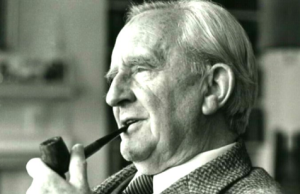 Bradley Birzer reminds us that J.R.R. Tolkien’s son Christopher contributed much to his father’s legacy. It took him four years to compile and edit The Silmarillion before it was ready for publication, and other works, from the elder Tolkien’s modernization of Beowulf to the latest work, The Fall of Gondolin, demanded years of patient scholarship.
Bradley Birzer reminds us that J.R.R. Tolkien’s son Christopher contributed much to his father’s legacy. It took him four years to compile and edit The Silmarillion before it was ready for publication, and other works, from the elder Tolkien’s modernization of Beowulf to the latest work, The Fall of Gondolin, demanded years of patient scholarship.
But in the same article, Birzer also points out how J.R.R. Tolkien gifted the world with his astonishing and profound creations, works that grew out of Tolkien’s personal losses and the soul-numbing trauma of war. Tolkien’s world-building not only helped him overcome the spiritual and emotional pain caused by his excruciating experience at the Somme, but has inspired countless readers as well.
What makes Tolkien so timeless is that his tales are much, much more than feel-good fables that end with the happy moral “You can do it!” And there’s more going on in Tolkien than the observation that “Fairy tales are more than true – not because they tell us dragons exist, but because they tell us dragons can be beaten.”
Tolkien’s insight into human nature is that there is such a thing as human nature, and that it springs from roots deeper and mightier than we can understand. While murder and greed and depravity certainly exist, we possess within us timeless ties to countless generations before us, generations whose courage and tenacity are part of us even when we forget them. As Birzer notes:
“Those familiar with The Lord of the Rings know how often the stories of the Elder Days appear at critical moments in the trilogy. When the Ringwraiths are about to attack the hobbits and Aragorn on Weather Top, the ranger tells the ancient and timeless story of Beren and Lúthien, almost as a preparatory prayer in anticipation of battle. Galadriel, in a moment of confession, admits she has lived in Middle-earth since before the fall of Gondolin. When Sam and Frodo wonder what their fate is as they approach Mount Doom, they compare their own experiences with those of a previous age, recognizing that they exist in the same story, just at a later time.”
This, I think, is another aspect of Tolkien’s enduring appeal. In an age that threatens to overwhelm us with mindless distractions, we need to remember our connections to those we love in the present and to those of the past who sacrificed so much so that we could live to carry the flame into the future.
—————
* Yes, it’s been some time since I posted. I’ve been up to my eyeballs in last-minute edits of my latest book, and am now in the process of polishing it for publication.
* The quote about fairy tales and dragons was first coined by G. K. Chesterton and re-worded by science fiction writer Neil Gaiman.
Like the Dude in “Big Lebowski,” Tolkien abides!
LikeLiked by 2 people
Daedalus Lex,
Indeed he does!
LikeLiked by 1 person
Reblogged this on Sue Vincent's Daily Echo.
LikeLiked by 1 person
Thank you, Sue!
LikeLike
My pleasure, Mike.
LikeLiked by 1 person
a mentor of mine, Dr. Rodney Needham, introduced me to J.R.R Tolkein in the early eighties at Merton College, U of Oxford. Tolkein advised me that the best way to prepare for my written examinations was to try to answer two questions: “Why do cultures around the world tell stories?; and, Why do all cultures have oral traditions the include the real and unreal? Those questions have carried me beyond my studies to inform my writing. I only met him once, but that was enough.
LikeLiked by 1 person
Baja Moto Quest,
You are most fortunate. We would greatly appreciate your response to his questions.
LikeLiked by 1 person
I’ve been on the road on my moto down in Baja and consequently unplugged. I will try to post the answers to those two question as soon as I get settled back home.
LikeLiked by 1 person
NEW BOOK? Good News!
LikeLiked by 1 person
Lara,
Indeed!
LikeLiked by 1 person
Great reeading your blog post
LikeLike